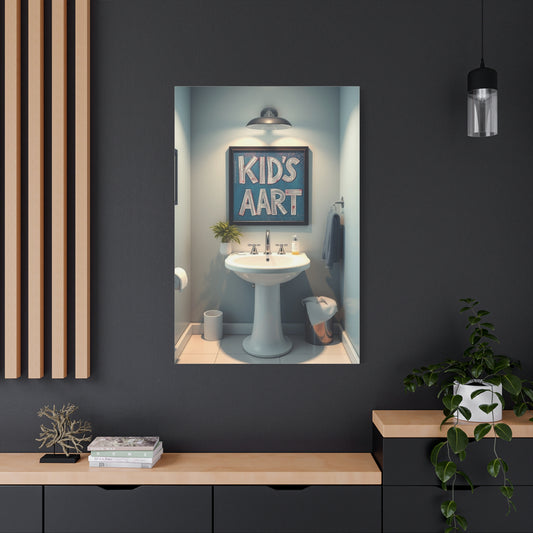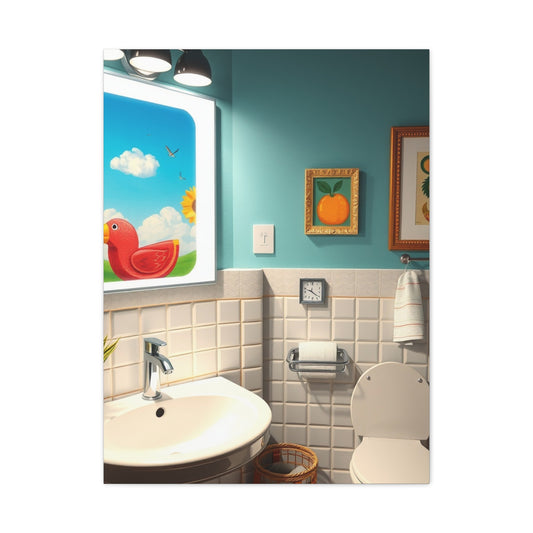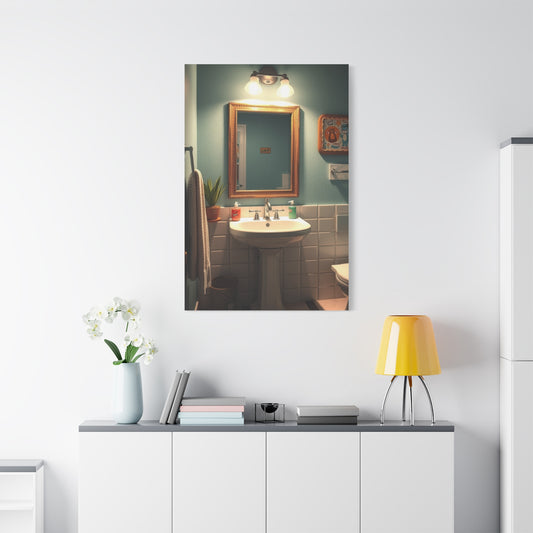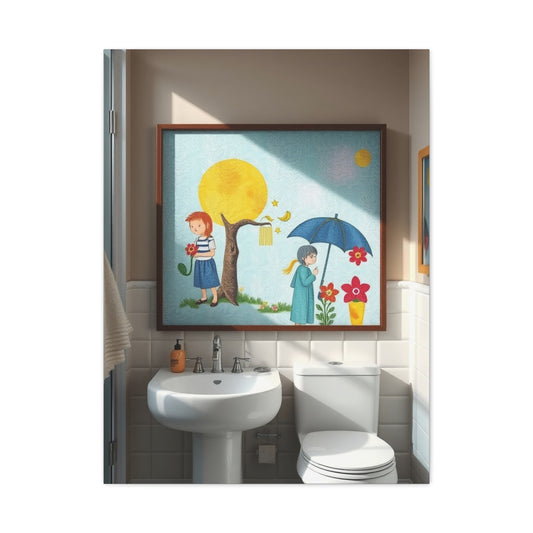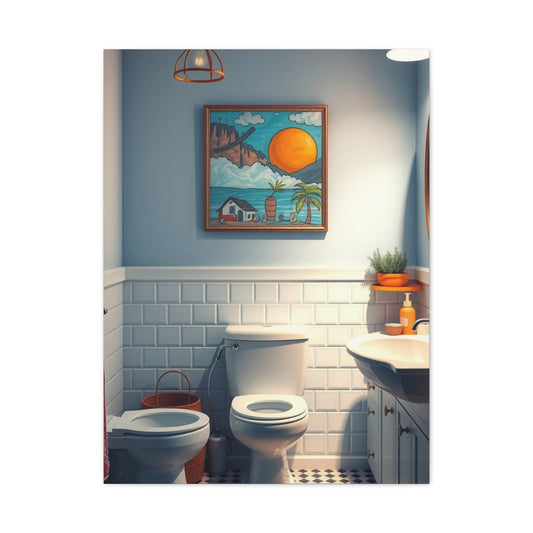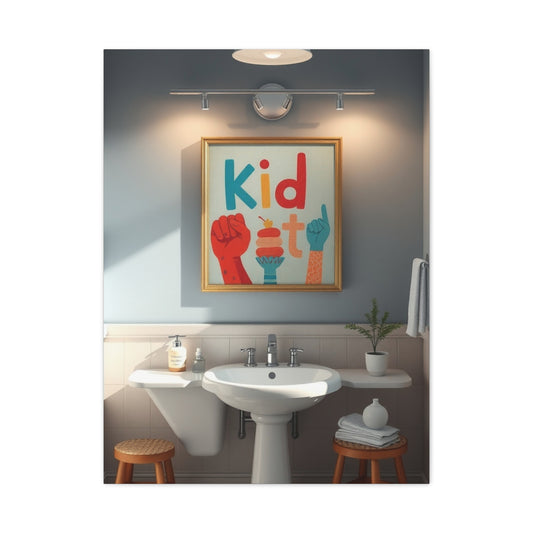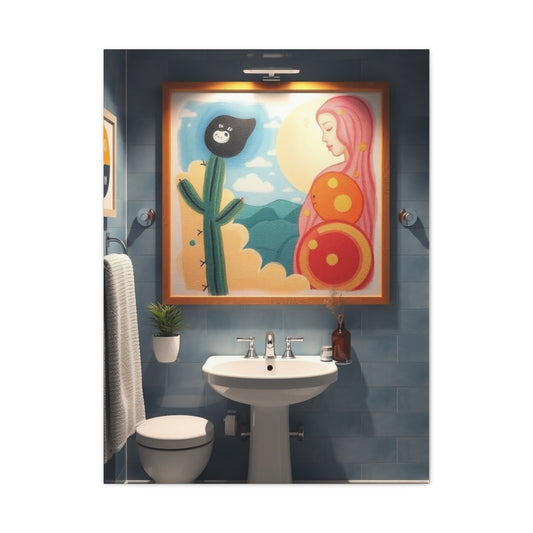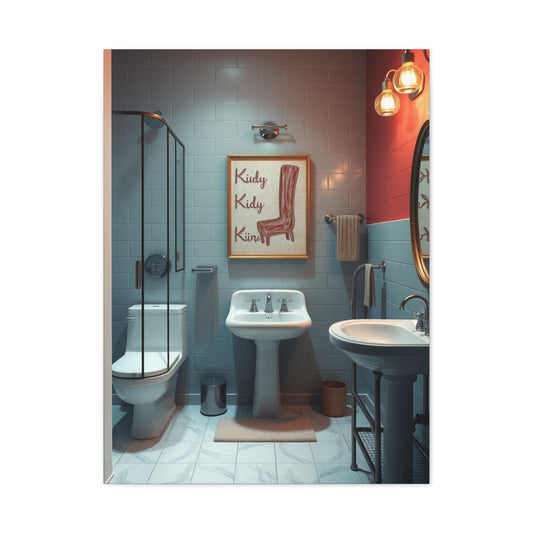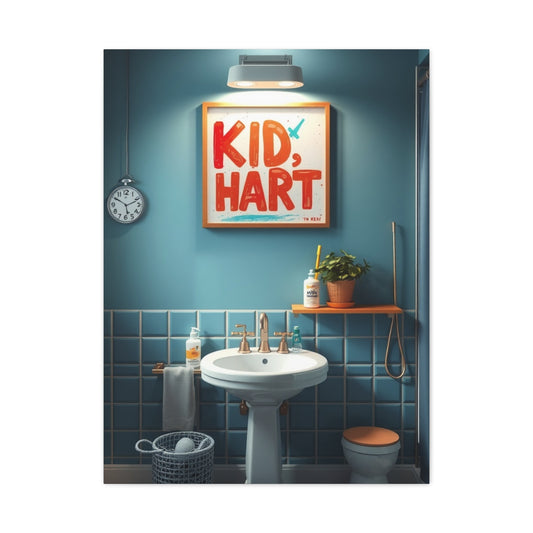Kid’s Bathroom Wall Art: Creating a Magical Space for Your Little Ones
Creating an enchanting bathroom environment for children requires careful consideration of both visual appeal and practicality. The bathroom serves as more than just a utilitarian space; it becomes a sanctuary where young minds can explore, learn, and develop positive associations with daily hygiene routines. Wall decorations play a pivotal role in establishing this atmosphere, transforming mundane activities into delightful experiences that children eagerly anticipate.
The selection of appropriate wall décor extends beyond mere aesthetics, encompassing developmental benefits, safety considerations, and long-term durability. Parents and designers must navigate numerous options while considering factors such as moisture resistance, easy maintenance, and age-appropriate content. This comprehensive exploration delves into various themes, materials, and design strategies that create captivating bathroom environments specifically tailored for young inhabitants.
Modern interior design recognizes the bathroom as an integral component of a child's personal space, deserving the same attention to detail as bedrooms or playrooms. The strategic placement of visual elements can significantly influence a child's perception of cleanliness, personal care, and even their developing sense of identity. Through thoughtful curation of wall art, parents can instill positive behaviors while simultaneously nurturing creativity and imagination.
Adorable Creature Illustrations for Young Bathers
Children possess an innate fascination with animals, making creature-themed wall art an exceptional choice for bathroom decoration. These illustrations serve multiple purposes beyond visual appeal, offering opportunities for learning, emotional connection, and imaginative play during bath time routines. The selection of animal-themed artwork requires consideration of both aesthetic harmony and developmental appropriateness.
Charming woodland creatures bring natural warmth to bathroom spaces while introducing children to diverse wildlife species. Forest animals such as deer, rabbits, foxes, and squirrels create a gentle, nurturing atmosphere that appeals to various age groups. These illustrations often feature soft color palettes and friendly expressions, promoting feelings of comfort and security during vulnerable moments like bathing or using the toilet independently.
Farm animal representations offer familiar comfort through recognizable characters that many children encounter in books, television, and real-life experiences. Cows, pigs, chickens, and horses provide educational value while maintaining an approachable, non-threatening presence. The rustic charm of barnyard scenes can complement various design schemes, from country cottage aesthetics to modern minimalist approaches.
Jungle and safari animals introduce excitement and adventure while maintaining child-friendly appeal. Lions, elephants, giraffes, and monkeys capture imagination through their exotic nature and distinctive characteristics. These illustrations often incorporate vibrant colors and dynamic poses that energize the space while encouraging curiosity about distant lands and diverse ecosystems.
Domestic pets hold special significance for many children, representing companionship, loyalty, and unconditional love. Cats, dogs, rabbits, and birds create emotional connections that extend beyond mere decoration, potentially serving as comfort objects during challenging moments. These familiar creatures help establish feelings of home and belonging within the bathroom environment.
The artistic style of animal illustrations significantly impacts their effectiveness in children's spaces. Watercolor renderings provide gentle, dreamy qualities that promote relaxation and calm. Bold, cartoon-style representations offer energy and playfulness that can motivate reluctant bathers. Realistic portrayals serve educational purposes while maintaining visual appeal. Mixed-media approaches combine various techniques to create unique, engaging compositions.
Size considerations play crucial roles in animal art placement and impact. Large-scale illustrations serve as focal points, commanding attention and creating dramatic effects. Medium-sized pieces allow for groupings and collections that tell stories or represent different habitats. Small illustrations work effectively as accent pieces, filling gaps and creating visual rhythm throughout the space.
Color coordination between animal artwork and overall bathroom design ensures cohesive aesthetics while maximizing visual impact. Neutral-toned animals complement various color schemes while maintaining timeless appeal. Brightly colored creatures add energy and excitement to otherwise subdued spaces. Monochromatic approaches create sophisticated looks that can grow with children as they mature.
Marine Life Masterpieces for Aquatic Adventures
Ocean-themed bathroom décor creates natural synergy between form and function, celebrating the connection between water and marine life. These aquatic designs transform everyday bathing activities into underwater explorations, encouraging children to embrace water-related activities with enthusiasm and wonder. The vast diversity of marine species provides endless inspiration for creative wall displays.
Majestic whale illustrations capture the grandeur and mystery of ocean depths while promoting respect for marine conservation. Blue whales, humpback whales, and orcas offer varying scales and characteristics that appeal to different personalities and preferences. These gentle giants often feature calming blue and gray color palettes that complement bathroom fixtures while creating serene atmospheres conducive to relaxation.
Intelligent dolphins represent playfulness, friendship, and aquatic agility through their characteristic smiles and dynamic movements. These beloved marine mammals frequently appear in jumping poses, creating sense of motion and energy that enlivens bathroom spaces. Their social nature and perceived intelligence make them ideal subjects for promoting positive associations with water activities.
Graceful sea turtles embody wisdom, longevity, and peaceful ocean navigation through their ancient presence and calm demeanor. These reptiles offer opportunities for environmental education while providing soothing visual elements that promote tranquility. Their distinctive shell patterns and patient expressions create focal points that encourage mindful moments during daily routines.
Colorful tropical fish bring vibrant energy through their diverse patterns, shapes, and brilliant hues. Angelfish, clownfish, tang fish, and parrotfish create underwater rainbows that stimulate visual interest and promote joy. These smaller marine creatures work effectively in groups, creating school formations that add movement and depth to wall compositions.
Mysterious deep-sea creatures introduce elements of wonder and discovery through their unique adaptations and ethereal appearances. Jellyfish, seahorses, and various bioluminescent species create magical atmospheres that spark curiosity about ocean mysteries. These otherworldly beings often feature translucent qualities and unusual forms that captivate young imaginations.
Coral reef ecosystems provide comprehensive underwater scenes that combine multiple marine species within single compositions. These complex environments offer educational value while creating immersive experiences that transport children to tropical waters. The intricate relationships between reef inhabitants demonstrate ecological connections while providing visually stunning displays.
Submarine and underwater exploration themes bridge the gap between marine life and human adventure, incorporating vessels, divers, and exploration equipment alongside sea creatures. These compositions appeal to children interested in adventure and discovery while maintaining aquatic themes. Treasure maps, sunken ships, and diving equipment add narrative elements that encourage storytelling and imaginative play.
Predatory Marine Creatures for Brave Young Explorers
Fierce ocean predators captivate children's imaginations while teaching respect for marine ecosystems and natural hierarchies. These powerful creatures, when presented appropriately, can inspire courage and fascination rather than fear, transforming bathroom spaces into thrilling underwater expeditions that celebrate the ocean's most impressive inhabitants.
Magnificent sharks represent strength, determination, and aquatic mastery through their streamlined forms and confident presence. Great white sharks, hammerhead sharks, and tiger sharks offer varying visual characteristics while maintaining approachable cartoon-style representations that emphasize curiosity over intimidation. These apex predators teach children about marine conservation while adding excitement to bath time routines.
Dynamic shark illustrations often feature movement and action, showing these creatures gliding through water with grace and purpose. Swimming poses, feeding behaviors, and social interactions provide educational content while maintaining visual appeal. The key lies in presenting these predators as fascinating creatures deserving respect rather than monsters to be feared.
Artistic interpretations of sharks can range from realistic scientific illustrations to whimsical cartoon characters, each serving different purposes and appealing to various age groups. Younger children often respond better to anthropomorphized versions with friendly expressions and reduced anatomical accuracy. Older children may appreciate more detailed, scientifically accurate representations that support learning and appreciation for marine biology.
Size variations in shark artwork create different emotional impacts and serve various design functions. Large-scale shark murals create dramatic focal points that command attention and establish underwater themes. Medium-sized illustrations work well in groups, showing different species or life stages. Smaller accent pieces can be scattered throughout the space, creating treasure hunt atmospheres that encourage exploration and discovery.
Educational elements enhance the value of predatory marine art by incorporating facts, habitat information, and conservation messages into visual presentations. Species identification labels, size comparisons, and behavioral descriptions transform decorative elements into learning tools. These additions support parental goals of combining entertainment with education during daily routines.
Safety considerations ensure that predatory marine themes remain appropriate for bathroom environments. Rounded corners, secure mounting systems, and moisture-resistant materials protect both artwork and occupants. Child-friendly interpretations avoid graphic content while maintaining the essential characteristics that make these creatures fascinating to young observers.
Gentle Sea Reptiles for Serene Bath Experiences
Sea turtles embody tranquility, wisdom, and oceanic grace through their ancient presence and peaceful navigation of marine environments. These beloved reptiles offer perfect subjects for bathroom wall art, combining educational value with calming visual presence that promotes relaxation during bath time activities. Their slow, deliberate movements and patient expressions create atmospheres conducive to mindful moments and peaceful reflection.
Ancient sea turtle species provide diverse visual options through their varying shell patterns, sizes, and colorations. Green sea turtles, loggerhead turtles, and hawksbill turtles each offer unique characteristics that appeal to different aesthetic preferences. These distinctions allow for educational discussions about biodiversity while maintaining cohesive underwater themes throughout bathroom spaces.
Artistic representations of sea turtles can emphasize different aspects of their appeal, from scientific accuracy to whimsical interpretation. Detailed illustrations showcase intricate shell patterns and anatomical features that support learning objectives. Simplified cartoon versions focus on emotional connection and relatability, often featuring expressive eyes and friendly demeanors that comfort young bathers.
Migration patterns and life cycle illustrations provide narrative elements that transform static artwork into storytelling opportunities. Scenes depicting turtle nesting behaviors, ocean journeys, and habitat interactions create educational content that extends beyond visual decoration. These comprehensive representations support discussions about environmental stewardship and marine conservation.
Underwater scenes featuring sea turtles within their natural habitats create immersive experiences that transport children to coral reefs and open ocean environments. Seagrass beds, kelp forests, and rocky outcroppings provide contextual backgrounds that enhance realism while introducing additional marine elements. These complex compositions offer extended visual exploration and discovery opportunities.
Swimming motion and graceful movement characterize effective sea turtle artwork, capturing the fluid nature of underwater navigation. Curved lines, flowing forms, and gentle expressions convey the peaceful essence of these remarkable creatures. Dynamic compositions showing multiple turtles or interaction with other marine life create engaging scenes that hold children's attention.
Size and scale considerations affect the emotional impact and practical application of sea turtle artwork. Large-scale installations create dramatic statements that establish underwater themes throughout the space. Smaller pieces work effectively in groups, creating migration scenes or family groupings that tell stories about turtle social behaviors and life stages.
Mythical Oceanic Beings for Imaginative Adventures
Enchanting mermaid themes transport children into realms of fantasy and magic while maintaining aquatic connections that complement bathroom environments. These mythical beings represent beauty, mystery, and oceanic wisdom through their dual nature as both human and marine creatures. Mermaid artwork encourages imaginative play while promoting positive associations with water activities and personal care routines.
Classical mermaid representations draw from traditional folklore and fairy tale imagery, featuring flowing hair, elegant tails, and serene expressions. These timeless interpretations appeal to children who enjoy classic stories and princess themes. The romantic nature of traditional mermaids creates dreamy atmospheres that promote relaxation and peaceful bath experiences.
Modern mermaid interpretations offer diverse representations that reflect contemporary values and inclusive perspectives. Various ethnicities, body types, and personality traits ensure that all children can find relatable characters within mermaid themes. These updated versions often feature active poses and confident expressions that promote empowerment and self-acceptance.
Underwater palace scenes provide elaborate backdrops for mermaid artwork, incorporating coral castles, treasure chambers, and magical underwater kingdoms. These detailed environments offer extensive visual exploration opportunities while supporting storytelling and imaginative play. The architectural elements add sophistication to mermaid themes while maintaining child-appropriate content.
Mermaid companions and marine friends expand the narrative possibilities of aquatic fantasy themes. Dolphins, sea horses, tropical fish, and other marine creatures serve as loyal companions in mermaid adventures. These supporting characters add depth to compositions while introducing additional educational opportunities about marine life and ecosystem relationships.
Magical elements enhance mermaid themes through the incorporation of underwater spells, mystical artifacts, and supernatural phenomena. Glowing pearls, enchanted tridents, and shimmering scales add wonder and excitement to mermaid scenes. These fantastical elements encourage creative thinking and imaginative exploration while maintaining appropriate content for bathroom environments.
Seasonal variations in mermaid themes allow for periodic updates and renewed interest in bathroom décor. Summer mermaids might feature bright, tropical settings with abundant sunshine and warm waters. Winter interpretations could incorporate ice palaces and arctic marine life. These rotating themes maintain freshness while extending the longevity of mermaid-based decoration schemes.
Vibrant Spectrum Displays for Cheerful Spaces
Rainbow-themed wall art introduces spectacular color combinations that energize bathroom spaces while promoting positivity and joy during daily routines. These prismatic displays offer versatility in design applications, from subtle accent pieces to bold statement walls that completely transform the spatial experience. The universal appeal of rainbows transcends age boundaries while maintaining particular resonance with young children.
Traditional rainbow arcs provide classic visual elements that work effectively across various design styles and color schemes. These curved formations can span entire walls or appear as smaller accent pieces, depending on spatial requirements and aesthetic goals. The gentle curvature of rainbow forms creates softening effects that balance angular bathroom fixtures and architectural elements.
Geometric rainbow patterns offer contemporary interpretations that appeal to modern design sensibilities while maintaining child-friendly appeal. Triangular arrangements, hexagonal formations, and abstract compositions provide sophisticated alternatives to traditional arc presentations. These geometric approaches can accommodate various spatial constraints while creating striking visual impacts.
Watercolor rainbow techniques create soft, dreamy effects that promote relaxation and artistic appreciation. These flowing interpretations often feature color bleeding and organic transitions that mirror natural rainbow phenomena. The gentle nature of watercolor presentations complements peaceful bath time activities while introducing children to artistic expression and color theory.
Bold, saturated rainbow displays provide high-energy environments that motivate active children and reluctant bathers. These vibrant presentations often feature pure, primary colors with sharp definitions and strong contrasts. The energizing effect of bold rainbows can transform morning routines into exciting adventures while encouraging enthusiasm for personal care activities.
Interactive rainbow elements incorporate moveable parts, textural variations, or dimensional components that engage multiple senses. Velcro attachments, sliding mechanisms, or removable pieces allow children to manipulate rainbow displays, creating personalized configurations and supporting fine motor skill development. These interactive features extend the entertainment value of wall décor beyond passive observation.
Rainbow integration with other themes creates cohesive design schemes that combine color excitement with specific interests or educational goals. Rainbow-colored marine life, spectrum-tinted animals, or prismatic fantasy elements maintain thematic consistency while incorporating diverse color palettes. These hybrid approaches maximize visual interest while accommodating multiple design objectives.
Lighting considerations enhance rainbow wall art through strategic illumination that emphasizes color vibrancy and creates atmospheric effects. Natural light sources can create actual rainbow projections through prisms or crystal elements. Artificial lighting systems can highlight specific color zones or create rotation effects that change throughout the day, maintaining visual interest and supporting circadian rhythms.
Subaquatic Fantasy Environments for Immersive Experiences
Comprehensive underwater scenes create complete environmental experiences that surround children with aquatic wonder during bathroom activities. These immersive displays transform walls into windows to underwater worlds, encouraging extended engagement with bath time routines while supporting imaginative play and educational exploration. The complexity of underwater environments offers numerous design opportunities and narrative possibilities.
Coral reef ecosystems provide rich, colorful backgrounds that showcase marine biodiversity while creating visually stunning displays. These complex habitats feature multiple species interactions, varied textures, and brilliant color combinations that capture attention and maintain interest. Educational opportunities abound through species identification, habitat relationships, and conservation awareness discussions.
Kelp forest scenes offer different underwater aesthetics through their vertical orientations and flowing movements. These towering underwater plants create cathedral-like atmospheres that inspire awe and respect for marine environments. The swaying motion suggested by kelp illustrations adds dynamic elements that contrast with static bathroom fixtures while maintaining peaceful undertones.
Deep ocean trenches introduce mystery and exploration themes through their dark, unknown qualities and unique inhabitants. Bioluminescent creatures, unusual formations, and extreme depth indicators create adventure atmospheres that appeal to curious children. These environments support discussions about scientific exploration and the vast unknowns that exist within our planet's oceans.
Tropical lagoons combine shallow water clarity with exotic marine life, creating paradise-like settings that promote relaxation and escape. Crystal-clear waters, colorful fish, and pristine sand bottoms establish vacation-like atmospheres that make daily routines feel special. These pleasant environments encourage positive associations with water activities and personal hygiene practices.
Rocky tide pools represent transition zones between land and sea, offering unique educational opportunities about marine adaptation and survival. Starfish, anemones, crabs, and various mollusks demonstrate diverse survival strategies while creating interactive visual experiences. These detailed microenvironments support close observation and discussion about marine biology and ecosystem relationships.
Underwater cities and fantastical settlements blend reality with imagination, creating unique environments that exist nowhere in nature. Atlantis-inspired architecture, mermaid communities, and futuristic submarine bases provide narrative frameworks for extended imaginative play. These fictional environments encourage creative thinking while maintaining aquatic themes that complement bathroom functions.
Swashbuckling Adventure Themes for Bold Young Sailors
Pirate-themed bathroom décor captures the spirit of adventure and exploration that resonates strongly with children seeking excitement and independence. These seafaring themes combine historical elements with imaginative storytelling, creating environments that encourage bravery, problem-solving, and creative play during daily routines. The romanticized nature of pirate adventures provides safe frameworks for exploring themes of courage and discovery.
Treasure map illustrations serve as both decorative elements and interactive features that engage children's problem-solving abilities and spatial reasoning skills. These detailed maps can incorporate bathroom fixtures as landmarks, creating personalized adventures that make the space feel uniquely special. Ancient parchment aesthetics and weathered appearances add authenticity while maintaining child-appropriate content.
Pirate ship designs offer dynamic focal points that establish narrative frameworks for bathroom adventures. Detailed vessels with billowing sails, crow's nests, and distinctive flags create scenes of maritime exploration and discovery. These ships can appear to sail across bathroom walls, suggesting movement and journey that transform routine activities into epic adventures.
Treasure chest imagery appeals to children's natural fascination with hidden riches and secret discoveries. These mysterious containers, often overflowing with gold coins, precious gems, and exotic artifacts, create anticipation and excitement about unknown possibilities. The promise of treasure adds elements of reward and achievement to daily hygiene accomplishments.
Island paradise settings provide destinations for pirate adventures while incorporating tropical beauty and exotic appeal. Palm trees, pristine beaches, and hidden coves create escape fantasies that make bathroom time feel like vacation experiences. These scenic backgrounds support relaxation while maintaining adventure themes that keep children engaged and interested.
Pirate character illustrations bring personality and relatability to adventure themes through diverse representations of seafaring heroes. Friendly pirates with approachable expressions and colorful costumes avoid intimidating elements while maintaining adventurous appeal. These characters can serve as role models for cleanliness, bravery, and personal responsibility.
Nautical equipment and maritime accessories add authentic details that enhance pirate themes while providing educational opportunities. Compasses, telescopes, anchors, and sailing equipment introduce children to navigation concepts and maritime history. These technical elements support STEM learning while maintaining decorative appeal and thematic consistency.
Weather and ocean condition representations create atmospheric effects that enhance the realism and excitement of pirate themes. Storm clouds, crashing waves, and dramatic sunsets establish mood and energy levels appropriate for different times of day. These environmental elements can be adjusted seasonally or based on desired emotional impacts.
Animated Aquatic Characters for Playful Atmospheres
Cartoon fish characters bring personality and humor to bathroom environments through exaggerated features, bright colors, and entertaining expressions. These anthropomorphized marine creatures create friendly atmospheres that reduce anxiety and promote positive associations with water activities. The playful nature of cartoon fish appeals to various age groups while maintaining visual appeal that encourages extended engagement.
Friendly fish families represent community, cooperation, and social learning through their group dynamics and interactions. Parent fish protecting young fry, schools swimming together, and diverse species cooperating create positive social models while maintaining entertaining visual content. These family structures support discussions about relationships, responsibility, and mutual care.
Silly fish expressions and exaggerated features provide humor and entertainment that can distract from discomfort or reluctance during bathing activities. Wide eyes, goofy grins, and comical poses create laughter and joy that transform bathroom routines into entertaining experiences. The absurd nature of cartoon exaggeration appeals to children's developing sense of humor and appreciation for absurdity.
Fish personality archetypes offer diverse characters that children can relate to and identify with during different moods or situations. Brave explorer fish, shy hiding fish, silly clown fish, and wise elder fish provide role models for various behaviors and attitudes. These character types support emotional development while maintaining entertaining presentation formats.
Underwater sports and activities show fish engaging in human-like behaviors that create humorous situations and relatable scenarios. Fish playing basketball, soccer, or other sports provide familiar contexts within underwater settings. These anthropomorphic activities bridge the gap between human interests and marine environments while maintaining playful appeal.
Fish fashion and accessories add contemporary elements that connect aquatic themes with current interests and trends. Sunglasses-wearing fish, fashionable fins, and trendy accessories create modern appeal while maintaining timeless aquatic foundations. These updated elements ensure that traditional fish themes remain relevant and engaging for contemporary children.
Seasonal fish celebrations incorporate holiday themes and special occasions into aquatic settings, allowing for periodic updates and renewed interest in bathroom décor. Birthday parties, holiday celebrations, and seasonal activities provide rotating content that maintains freshness while supporting year-round engagement with bathroom spaces.
Dynamic Water Movement Illustrations for Energy and Motion
Ocean wave artwork captures the power, beauty, and rhythmic nature of water movement while creating dynamic visual experiences that energize bathroom spaces. These flowing designs complement the fundamental water-based functions of bathrooms while introducing natural movement patterns that create visual interest and emotional impact. The versatility of wave imagery allows for various interpretations and applications.
Gentle rolling waves provide peaceful, meditative qualities that promote relaxation and calm during bath time activities. These soft, undulating forms create soothing backgrounds that encourage stress relief and mindful moments. The repetitive nature of wave patterns can have hypnotic effects that support relaxation and peaceful reflection during daily routines.
Dramatic crashing waves introduce excitement and energy through powerful displays of natural force and movement. These dynamic illustrations can motivate reluctant bathers while celebrating the awesome power of water. The dramatic nature of crashing waves appeals to children who enjoy excitement and adventure, transforming routine activities into thrilling experiences.
Stylized wave patterns offer artistic interpretations that emphasize design elements over realistic representation. Japanese-inspired wave motifs, geometric wave formations, and abstract water movements provide sophisticated alternatives to photorealistic presentations. These artistic approaches can complement various design styles while maintaining water-themed consistency.
Wave color variations create different moods and energy levels through strategic color selection and application. Blue waves maintain traditional oceanic associations while providing calming effects. Green waves might suggest tropical or freshwater environments. Multi-colored waves add excitement and energy while supporting rainbow themes or seasonal celebrations.
Foam and bubble details enhance wave illustrations through textural elements that suggest the tactile qualities of water interaction. These detailed additions create more immersive experiences while connecting visual elements to actual bath time activities. The presence of bubbles and foam reinforces connections between artwork and bathroom functions.
Seasonal wave interpretations allow for periodic updates that maintain interest while reflecting changing environmental conditions. Summer waves might feature bright sunshine and calm conditions. Winter representations could include stormy seas and dramatic weather. These seasonal variations support discussions about weather, climate, and natural cycles.
Interactive wave elements can incorporate moveable parts or dimensional features that engage children's tactile senses and motor skills. Flowing fabric attachments, sliding mechanisms, or textural components allow physical interaction with wave themes. These hands-on elements extend engagement beyond visual observation while supporting sensory development.
Translucent Marine Drifters for Ethereal Beauty
Jellyfish artwork introduces ethereal beauty and mysterious wonder to bathroom environments through these creatures' unique translucent qualities and graceful movements. These ancient marine animals represent different aesthetic possibilities from traditional fish or mammal themes, offering opportunities for both artistic expression and scientific education. Their otherworldly appearance captivates children's imaginations while promoting appreciation for marine diversity.
Bioluminescent jellyfish displays create magical atmospheres through glowing effects and luminous presentations. These light-producing capabilities can be simulated through glow-in-the-dark materials, LED integration, or strategic lighting placement. The mystical quality of glowing jellyfish transforms ordinary bathroom spaces into enchanted underwater realms that fascinate and delight young observers.
Flowing tentacle movements provide dynamic visual elements that suggest gentle motion and fluid grace. These streaming appendages can be represented through various artistic techniques, from realistic anatomical accuracy to stylized interpretations that emphasize movement and flow. The organic curves of tentacles create softening effects that balance angular bathroom architecture.
Transparent body structures showcase the unique anatomical features that distinguish jellyfish from other marine creatures. Bell-shaped forms, internal structures, and translucent qualities provide educational opportunities while creating visually striking presentations. These distinctive characteristics make jellyfish artwork easily recognizable while supporting discussions about marine adaptation and survival strategies.
Group formations and jellyfish blooms create comprehensive underwater scenes that demonstrate natural behaviors and social patterns. Multiple jellyfish floating together suggest the peaceful coexistence and collective beauty of these creatures in their natural habitats. These group presentations offer opportunities for counting, pattern recognition, and discussion about marine ecosystem dynamics.
Artistic interpretation varieties allow jellyfish themes to accommodate different aesthetic preferences and design requirements. Realistic scientific illustrations support educational goals while maintaining visual appeal. Abstract interpretations emphasize color, form, and movement over anatomical accuracy. Cartoon versions feature friendly expressions and simplified forms that appeal to younger children.
Size and scale variations in jellyfish artwork create different visual impacts and serve various functional purposes. Large-scale jellyfish create dramatic focal points that establish underwater themes throughout the space. Medium-sized pieces work effectively in groups, creating bloom effects or suggesting underwater gardens. Smaller jellyfish can serve as accent pieces that fill gaps and create visual rhythm.
Color palette considerations affect the mood and energy levels of jellyfish-themed spaces. Traditional clear and white jellyfish maintain subtle, sophisticated appearances that complement various color schemes. Brightly colored interpretations add energy and excitement while departing from realistic representations. Monochromatic approaches create elegant, cohesive looks that can mature with children's developing tastes.
Coastal Treasures for Beach-Inspired Environments
Starfish and seashell collections bring the charm of beach discoveries into bathroom spaces, creating connections between bath time activities and seaside adventures. These coastal treasures represent exploration, discovery, and natural beauty through their diverse forms, patterns, and textures. The collectible nature of shells and starfish appeals to children's gathering instincts while providing educational opportunities about marine biology and coastal ecosystems.
Five-pointed starfish designs offer symmetrical beauty and mathematical perfection that appeals to both artistic and scientific sensibilities. These radial forms create natural focal points while demonstrating geometric principles found throughout nature. Various starfish species provide color and size diversity that accommodates different design requirements and aesthetic preferences.
Diverse seashell varieties showcase the incredible diversity of mollusk architecture and adaptation strategies. Conch shells, scallop shells, nautilus shells, and countless other varieties provide educational content while creating beautiful display collections. The spiral patterns, ribbed textures, and varied colorations of shells offer rich visual experiences that support both decoration and learning objectives.
Sandy beach scenes provide contextual backgrounds for starfish and shell displays, creating comprehensive coastal environments that suggest complete seaside experiences. These beach settings can incorporate dunes, sea grass, and coastal vegetation that provide realistic habitats for featured marine treasures. The golden tones and organic textures of beach scenes create warm, inviting atmospheres.
Tide pool ecosystems combine starfish and shells with other coastal creatures, creating educational displays about intertidal zone habitats and species interactions. Hermit crabs, sea anemones, and various algae species demonstrate the complex relationships that exist in these dynamic environments. These comprehensive scenes support extended observation and discussion about marine ecology.
Collection and arrangement principles guide the effective presentation of multiple starfish and shell elements within bathroom spaces. Grouping similar species, creating size progressions, and establishing visual rhythms prevent cluttered appearances while maximizing educational and aesthetic impact. These curatorial approaches help children understand organization, classification, and pattern recognition.
Textural representations enhance starfish and shell artwork through dimensional elements, varied materials, or tactile components that simulate actual specimen handling. Raised surfaces, rough textures, and smooth finishes provide sensory experiences that support learning while adding visual interest. These textural variations create more engaging and memorable display experiences.
Seasonal beach themes allow for periodic updates that reflect changing coastal conditions and activities. Summer beach scenes might feature bright sunshine and active wildlife. Winter presentations could showcase storm-swept shores and resilient creatures. These rotating displays maintain freshness while supporting discussions about seasonal changes and environmental adaptation.
Intelligent Cephalopods for Wonder and Learning
Octopus characters combine intelligence, adaptability, and visual appeal through their unique anatomical features and remarkable behavioral capabilities. These fascinating creatures offer excellent subjects for bathroom wall art, providing educational opportunities while maintaining entertaining presentations that capture children's attention and imagination. The complex nature of octopus biology supports extended learning discussions while their appearance creates striking visual displays.
Eight-armed anatomy provides distinctive visual characteristics that make octopus artwork immediately recognizable and visually interesting. The flowing, flexible nature of octopus arms creates dynamic compositions that suggest movement and activity. These appendages can be arranged in various configurations to fit different spatial requirements while maintaining anatomical authenticity or artistic interpretation.
Color-changing abilities represent one of the most fascinating aspects of octopus biology, providing opportunities for educational discussions while creating visually spectacular artwork. Illustrations showing color transitions, pattern changes, and camouflage demonstrations captivate children while teaching about adaptation and survival strategies. These dynamic presentations can suggest movement and change that adds excitement to static wall displays.
Problem-solving demonstrations showcase octopus intelligence through illustrations of tool use, maze navigation, and puzzle solving. These behavioral displays support discussions about animal intelligence while providing role models for persistence, creativity, and logical thinking. Educational content about octopus cognitive abilities can inspire children to develop their own problem-solving skills.
Garden and habitat scenes place octopus characters within their natural environments, creating comprehensive underwater displays that demonstrate ecological relationships and environmental context. Rocky crevices, coral formations, and sandy bottoms provide realistic settings while introducing additional marine elements. These complex habitats support extended observation and discussion about ecosystem dynamics.
Friendly octopus personalities transform potentially intimidating creatures into approachable characters that children can relate to and enjoy. Cartoon interpretations with expressive eyes, friendly smiles, and playful poses create emotional connections while maintaining educational value. These personified versions can serve as bathroom companions that encourage positive behaviors and routines.
Interactive octopus elements incorporate moveable arms, textural components, or dimensional features that engage children's tactile senses and motor skills. Flexible appendages that can be repositioned, textured surfaces that simulate skin characteristics, or puzzle components that demonstrate problem-solving create hands-on learning experiences that extend beyond visual observation.
Cultural octopus representations introduce diversity and global perspectives through artwork inspired by different cultural traditions and artistic styles. Japanese tako imagery, Mediterranean interpretations, and contemporary artistic movements provide varied aesthetic approaches while maintaining octopus themes. These cultural variations support discussions about global perspectives and artistic diversity.
Effervescent Bubble Displays for Playful Decoration
Bubble-themed wall art celebrates the simple joy and wonder that soap bubbles bring to bath time experiences, transforming these fleeting phenomena into permanent decorative elements that maintain their magical appeal. These spherical forms represent play, cleanliness, and transformation while providing versatile design elements that complement various aesthetic approaches and color schemes.
Floating bubble arrangements create sense of movement and lightness that counterbalances the solid, permanent nature of bathroom fixtures and architecture. These ascending compositions suggest air and freedom while maintaining aquatic connections through their association with bath activities. The varied sizes and positions of floating bubbles create visual rhythm and dynamic interest.
Iridescent surface effects capture the rainbow qualities that make real bubbles so captivating, incorporating multiple colors within single spherical forms. These prismatic displays combine bubble themes with rainbow elements, creating multifaceted decorative solutions that maximize visual impact. The shifting, ephemeral nature of bubble colors can be suggested through artistic techniques that create depth and dimension.
Cluster formations and bubble clouds provide comprehensive displays that suggest the abundance and joy associated with successful bath time activities. These grouped presentations create focal points while maintaining the light, playful nature of individual bubbles. Dense formations can fill larger wall areas while scattered arrangements provide accent elements throughout the space.
Interactive bubble elements incorporate tactile components or moveable features that allow children to manipulate bubble displays and create personalized arrangements. Pop-able surfaces, sliding mechanisms, or magnetic attachments provide hands-on engagement while supporting fine motor skill development. These interactive features extend the entertainment value of bubble themes beyond passive observation.
Bubble-making equipment and related accessories introduce educational elements about surface tension, air pressure, and the science behind bubble formation. Bubble wands, soap dispensers, and mixing bowls can be incorporated into bubble-themed displays while supporting STEM learning opportunities. These technical elements provide context for bubble phenomena while maintaining decorative appeal.
Character integration allows bubbles to interact with other thematic elements, creating narrative possibilities and enhanced storytelling opportunities. Fish blowing bubbles, mermaids surrounded by bubble streams, or cartoon characters playing with bubbles create connections between different design themes while maintaining cohesive presentations.
Conclusion:
Creating the ideal bathroom for children goes far beyond the practicalities of function and hygiene. It involves crafting an environment that fosters imagination, nurtures creativity, and encourages positive associations with personal care routines. Wall art plays a pivotal role in transforming a bathroom from a mere utilitarian space into a vibrant, engaging, and enjoyable sanctuary for young ones. With the right selection of themes, colors, and materials, children’s bathroom walls can become canvases of inspiration, joy, and learning.
One of the most exciting aspects of designing a children's bathroom is the vast array of themes and artistic possibilities available. Whether through the incorporation of animal illustrations, marine life scenes, or rainbow-themed art, the options are endless and adaptable to various age groups, tastes, and developmental stages. Animal-themed art, for example, introduces a delightful way to educate children about the world around them. The charm of forest animals, farm creatures, and marine life adds a natural, soothing atmosphere that sparks curiosity and excitement. This not only brings joy but offers teachable moments about animals and nature, fostering an early appreciation for the environment.
Similarly, aquatic themes, such as whales, dolphins, sea turtles, and other marine creatures, seamlessly blend beauty with educational value. These pieces transport children to underwater worlds, promoting wonder and offering lessons about the ocean and marine conservation. As children grow, these themes can evolve, introducing more complex ecological and environmental narratives that deepen their understanding of nature. Whether it’s the soothing motion of sea turtles or the majestic presence of a whale, marine life-themed wall art is not just visually stunning but mentally enriching.
The importance of color in a child’s bathroom cannot be underestimated either. Color psychology plays a significant role in shaping a child’s emotional responses and behavior. Soft, pastel tones promote relaxation and calmness, ideal for fostering peaceful bath times, while brighter, more vibrant colors stimulate energy, creativity, and excitement. The use of rainbow themes or bright hues in the artwork adds an element of playfulness, helping create a cheerful and welcoming space. This burst of color, when harmoniously incorporated with other elements in the room, elevates the mood and contributes to a more positive and energetic atmosphere.
One of the fundamental goals of children’s bathroom wall art is to create an environment where kids can feel safe, excited, and motivated. The art serves as more than just decoration—it helps establish a positive emotional connection to the space, shaping the child’s perception of cleanliness, hygiene, and self-care. When children feel joy and excitement about their surroundings, they are more likely to develop healthy habits and enjoy routine tasks like brushing their teeth or taking a bath. Art helps turn what might otherwise feel like a chore into an enjoyable activity that they look forward to.
Moreover, the inclusion of whimsical and imaginative themes, such as mythical creatures or rainbow displays, supports the development of a child’s creativity and imagination. These themes not only enhance the room’s aesthetic appeal but also provide opportunities for storytelling, role-play, and creative thinking. By introducing these imaginative elements, children are encouraged to explore their own creativity and engage in playful activities that foster cognitive and emotional growth.
In conclusion, children’s bathroom wall art is an essential part of creating a space that nurtures both the imagination and the well-being of young ones. By thoughtfully selecting artwork that resonates with children’s interests and developmental needs, parents can create a room that is both visually appealing and functionally enriching. Through the use of playful, educational, and imaginative designs, the bathroom can become a magical environment that fosters creativity, nurtures good habits, and creates lasting positive memories. A well-designed children’s bathroom, complete with enchanting wall art, serves as a testament to the power of design in shaping the emotional and psychological experiences of children, making daily routines an exciting and joyful part of their lives.

